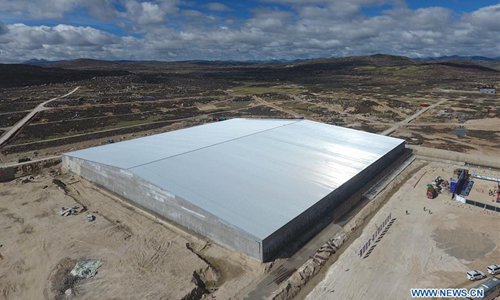Chinese scientists' pursuit of cosmic rays opens windows on universe
Source:Xinhua Published: 2019/10/23 17:15:43

Aerial photo taken on June 19, 2018 shows the Large High Altitude Air Shower Observatory (LHAASO) under construction in Daocheng County, southwest China's Sichuan Province. An observatory for detecting cosmic rays is being built in Sichuan Province. The project, known as the LHAASO, is located in mountains of the eastern part of Qinghai-Tibet Plateau at an average altitude of 4,410 meters.Photo:Xinhua
In the wilderness of Daocheng, southwest China's Sichuan Province, 4,400 meters above sea level, Chinese scientists are constructing a cosmic ray observation station on an area equivalent to 200 soccer fields.
Huge rocks left from the Ice Age have been blasted. Different detectors are being installed to form a huge "net" to catch the particles generated by cosmic rays in the atmosphere, to help scientists study both the micro and the macro worlds in the universe.
Three huge underground pools, more than triple the size of the Water Cube (National Aquatic Center) in Beijing, will hold detectors to collect high-energy photons generated by remote celestial bodies. Beside the pools, 12 telescopes will be erected to conduct high-precision measurement of cosmic rays with the highest energy.
Construction of the first half of the observation station, known as Large High-Altitude Air Shower Observatory (LHAASO), is due to be finished at the end of this year, and the whole project completed at the end of 2020, said Cao Zhen, chief scientist of LHAASO and a researcher at the Institute of High Energy Physics (IHEP) of the Chinese Academy of Sciences.
The main objective of LHAASO is to search for the origin of cosmic rays, and study their acceleration and transmission mechanisms, said Cao.
In the second huge pool of LHAASO, which is 5 meters below ground, water Cherenkov detectors have been installed to form an array, and they will be submerged in 100,000 tonnes of the purest water in the world.
"The water comes from nearby lakes and rivers and has gone through strict purification. Only transparent pure water can make the detectors catch the signals generated by high-energy particles clearly," said Chen Mingjun, deputy director of the Cherenkov detector array.
After being on the plateau for a year, Chen lost more than 15 kg due to the hard work, but he said he is lucky to participate in such a grand project.
Foreign peers have been amazed at the speed of LHASSO's construction. It's not only a result of the scientists' efforts, but also of the complete industrial production capacity of China. It's the embodiment of China's overall national strength, said Cao.
He said the LHASSO project has drawn world attention. Scientists from Russia, Switzerland, Poland, the Czech Republic and other countries hope to bring their scientific equipment to the observatory.
Research teams from Australia and Thailand and other countries will participate in the project directly. Some well-known international research teams expressed the desire to conduct cooperation and joint observation with LHASSO, said Cao.
"After completing the LHASSO project, China is expected to lead the world in the field of cosmic ray research," Cao said.
RELATED ARTICLES:
Posted in: SOCIETY,AIR & SPACE